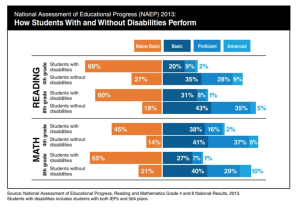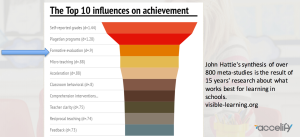Webinar Recap: Better Goals for Better Outcomes: How High Quality Goals Can Have a Significant Impact on Student Achievement
September 28, 2016
 Accelify’s Dr. Danielle Damico discusses the key components of setting high quality goals for students with disabilities
Accelify’s Dr. Danielle Damico discusses the key components of setting high quality goals for students with disabilities
It is the beginning of another school year, and whether you are a special ed teacher reviewing goals for a new group of students, a therapist working on writing goals for a brand new IEP, or a general education teacher writing SMART goals, goals are quite likely a significant part of your back-to-school scramble. On September 21st, Accelify’s own Customer Support and Training Manager, Dr. Danielle Damico spent an hour with educators from across the country discussing best-practices for writing goals and how high quality goals can lead to improved outcomes for students. Below are a few key points covered in the webinar:
The Importance of Goals
Dr. Damico began the webinar with a discussion of the importance of setting goals, particularly for students with disabilities. According to recent NAEP scores, students with disabilities are performing far below their general education peers in every category, and writing effective goals can make the difference in helping to close this achievement gap.

For these students, goals serve as the foundation for the student’s educational program, so their significance can not be understated. Furthermore, goals serve as the basis for determining whether these educational programs are effective. Because goals set the basis for what we will teach students and how, “Our concern for the quality of our goals should be proportional to the quality of our instructional efforts” (Popham and Baker, 1970).
Finally, while high quality goals are critical to setting students up for success, they are also required by IDEA. Dr. Damico went on to review the specific criteria laid out in IDEA for what an IEP goal should look like, as well as the further clarification provided by OSERS. It is important to remember that while IDEA does specify criteria for goals, it only provides the minimum requirements.
In summary, IDEA/OSERS specify that goals should:
- Be measurable
- Be focused on enabling progress
- Should consider present levels of performance and growth
- Be data driven
- Should be focused on closing gaps
- Be used within a process of formative evaluation
What the Research Tells Us About Goals and Goal Setting
Everything we do in our classrooms and especially with our students should be supported by research. The research base on effective goal writing includes an abundance of literature that can be difficult to sift through, but Dr. Damico highlighted some of the most powerful research out there that has shown what factors contribute most to student achievement when it comes to goal setting.
- Formative Evaluation is Key
According to John Hattie’s synthesis of over 800 meta-studies, formative evaluation–the ongoing use of data to measure a student’s progress–is one of the top 10 influencers on student achievement.

According to the research, teacher’s use of formative evaluation using a curriculum-based measurement approach resulted in significant gains for student reading outcomes compared to the reading outcomes of students whose teachers did not use formative evaluation.
Why is formative evaluation so impactful? For one, regular progress monitoring helps teachers respond to student data and make instructional changes based upon this data. Similarly, teachers who are using instruction recommendations tied to their own data tend to have more variety in what and how they teach, leading to greater learning opportunities for students.
From a student perspective, formative evaluation can help students better understand their own goals and progress. Students who see their ongoing progress toward goals have increased motivation and achieve better outcomes. Additionally, knowing what their goals are and seeing their progress toward them can help students better direct their attention, focus and increase their efforts, and lead to action.
- Feedback Makes Goals Meaningful
Formative evaluation and feedback are closely related. They are both ongoing and take place while the learning is happening, not after it is over. Feedback is critical in a highly-effective practice. One of the most powerful ways of making a goal meaningful is by providing students with feedback on their progress toward achieving their goals. Based upon research on what effective feedback looks like, Dr. Damico pointed out a few key points to remember when giving students feedback on their goals:
- Feedback is not advice Feedback is information about how we are doing toward reaching our goals.
- Feedback occurs during learning, so students have time to respond
- Most feedback comes from other students, and this feedback is often wrong
- To be effective, feedback should be provided in the context of goals and targets.
- High Quality Goals Contain Specific Components
While formative evaluation and feedback are critical to ensuring goals are meaningful for students, writing a successful goal is critical to doing either with success. In order for goals to lead to increased achievement, goals must be difficult, but attainable, explicit and precise, observable and measurable, and finally, written in consideration of a student’s self-efficacy or beliefs about the ability to achieve the goal. More specifically, a high quality goal should be sure to include a condition, an observable behavior, and mastery criteria In the next portion of the webinar, Dr. Damico discusses how to set goals that meet this criteria, including steps for setting goals as well as things to consider as goal setting is happening.
To create high quality goals that include all of the above components, educators should follow the following steps when setting goals:
- Determine the present level of performance: be sure to consider what sources of objective data are available to you when considering a student’s present level. There is of course your own observational data, but also consider at looking at data from a previous teacher or a student’s standardized test scores.
- Know the time frame for the goal: be sure to be specific about in what timeframe the student will complete this goal.
- Determine the conditions under which the desired behavior should be displayed: this is where being explicit and specific comes into play. For instance, if the goal is for a student to use scissors independently 100% of the time, consider defining the context, ie. during cutting and drawing activities. Or if the goal is for a student to retell the key events of a story in complete sentences, the context may also be important, during a retell of grade-level text. Remember, determining the conditions is key to making the goal measurable.
- Define the criterion for acceptable performance (CAP): We never want the criteria to seem as if it is pulled out of a hat. When defining criteria, consider what sources of data you can use to inform the criteria. For instance, are you using benchmarks? Norms? Student Growth percentiles?
Finally, knowing what to avoid when setting goals can help you ensure you are setting high quality goals that will improve outcomes for your students. A few of the most common mistakes when it comes to goal setting include:
- Writing compliance driven goals
- Writing broad and bague goals
- Writing goals that are too specific
- Goals are not individualized for students
Measuring Progress Toward Goals
Setting a high quality goals is not enough; student progress toward the goal must be monitored on frequent basis. Before concluding with the practical application portion of the webinar in which sample goals were discussed and critiqued, Dr. Damico elaborated on the importance of formative evaluation when it comes to measuring goals, specifically discussing the importance of graphing to monitor progress and outlining a specific process for formative evaluation.
To learn more about what it takes to set high quality goals and to formatively assess these goals so as to provide meaningful feedback to your students, we encourage you to check out the slides below and to watch the on-demand recording of the webinar here.